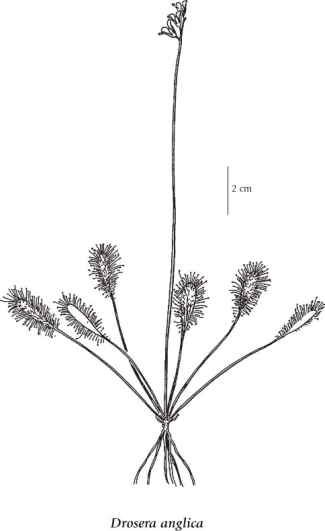Drosera anglica Huds.
great sundew (English sundew)
Droseraceae (Sundew family)
Introduction to Vascular Plants
great sundew (English sundew)
Droseraceae (Sundew family)
Introduction to Vascular Plants
Species Information
General:
Insect-eating perennial herb; stems erect, 5-18 cm tall.
Leaves:
Basal leaves erect or ascending, the blades oblong-oblanceolate to oblong spoon-shaped, 1-4 cm long, 3-7 mm wide, the stalks 2-6 cm long, hairy, the long, reddish blade-hairs on upper surface stalked with gland-tipped, sticky, insect-trapping fluid; stem leaves lacking.
Flowers:
Inflorescence of raceme-like terminal cymes of 1-7 flowers, opening in full sun in a coiled cluster on one side of the stem; petals white, 6-10 mm long; calyces 4-6 mm long, fused to at least 1/3 their length.
Fruits:
Capsules, many seeded; seeds 1-1.5 mm long, egg-shaped, black.
Illustration

If more than one illustration is available for a species (e.g., separate illustrations were provided for two subspecies) then links to the separate images will be provided below. Note that individual subspecies or varietal illustrations are not always available.
Illustration Source: The Illustrated Flora of British Columbia
Ecology
Ecological Framework for Drosera anglica
The table below shows the species-specific information calculated from
original data (BEC database) provided by the BC Ministry of Forests and Range.
(Updated August, 2013)
The table below shows the species-specific information calculated from
original data (BEC database) provided by the BC Ministry of Forests and Range.
(Updated August, 2013)
| Site Information |
Value / Class |
||
|
Avg |
Min |
Max |
|
| Elevation
(metres) |
767 | 7 | 1565 |
| Slope
Gradient (%) |
1 | 0 | 36 |
|
Aspect (degrees) |
354 | 20 | 360 |
| Soil
Moisture Regime (SMR) [0 - very xeric; 4 - mesic; 8 - hydric] |
7 | 6 | 8 |
| Modal
Nutrient Regime
Class |
B | ||
| #
of field plots species was recorded in: |
179 | ||
| Modal
BEC Zone Class |
SBS | ||
|
All BEC Zones (# of stations/zone) species was recorded in |
BWBS(7), CWH(43), ESSF(14), ICH(38), IDF(3), MH(1), MS(8), SBPS(1), SBS(58) | ||
|
Source:
Klinkenberg 2013
|
|||
Habitat and Range
Swamps, bogs, fens, wet meadows and lakeshores in the lowland, steppe and montane zones; frequent in S BC, rare northward; circumpolar, N to AK, YT and NT, E to NF and S to MI, WI, ID, NV and N CA; Eurasia, Hawaii.Status Information
Synonyms
Synonyms and Alternate Names:
Drosera longifolia L.